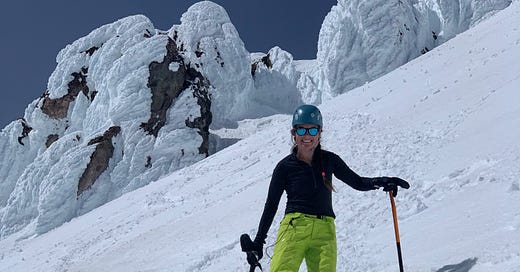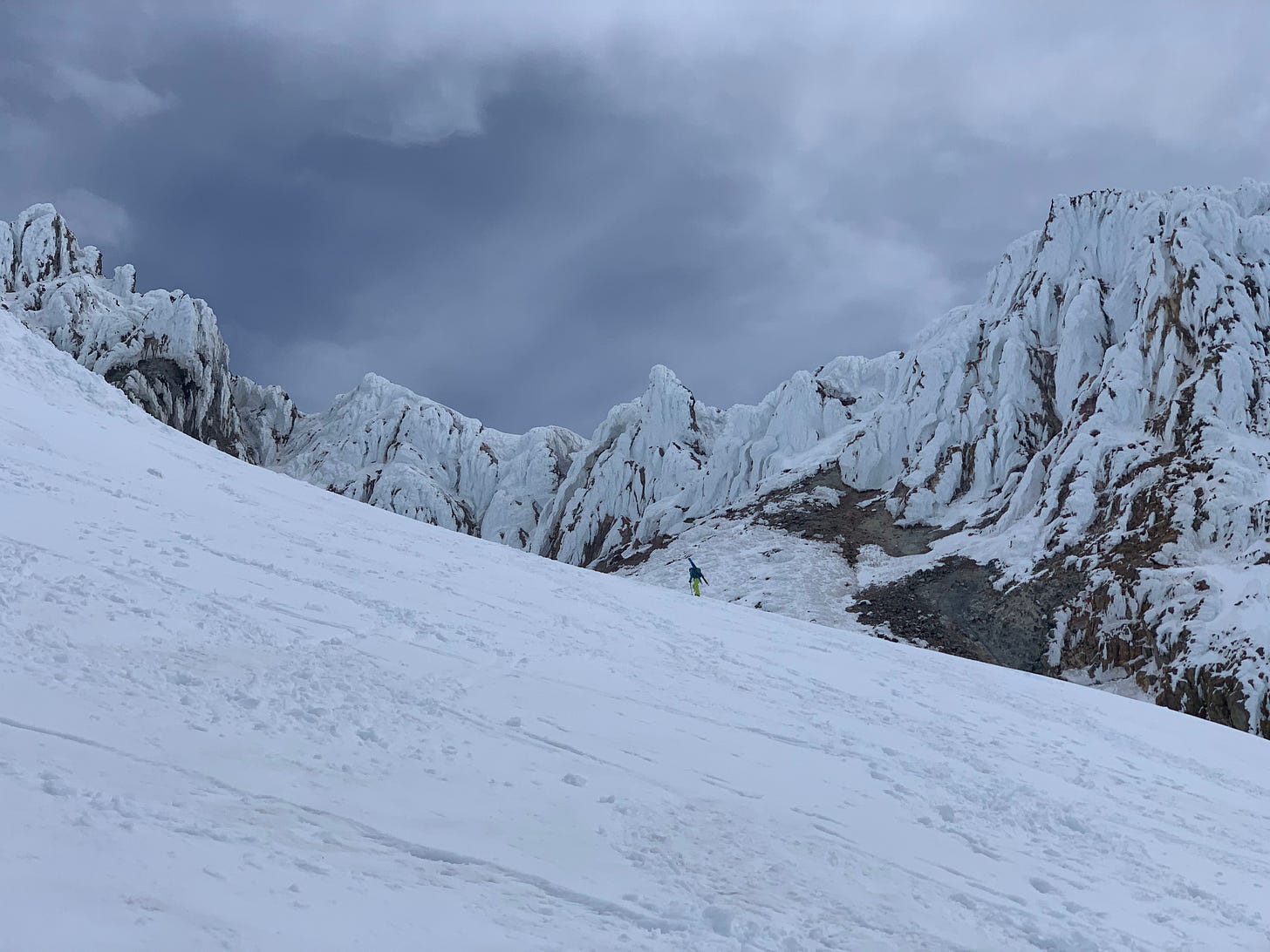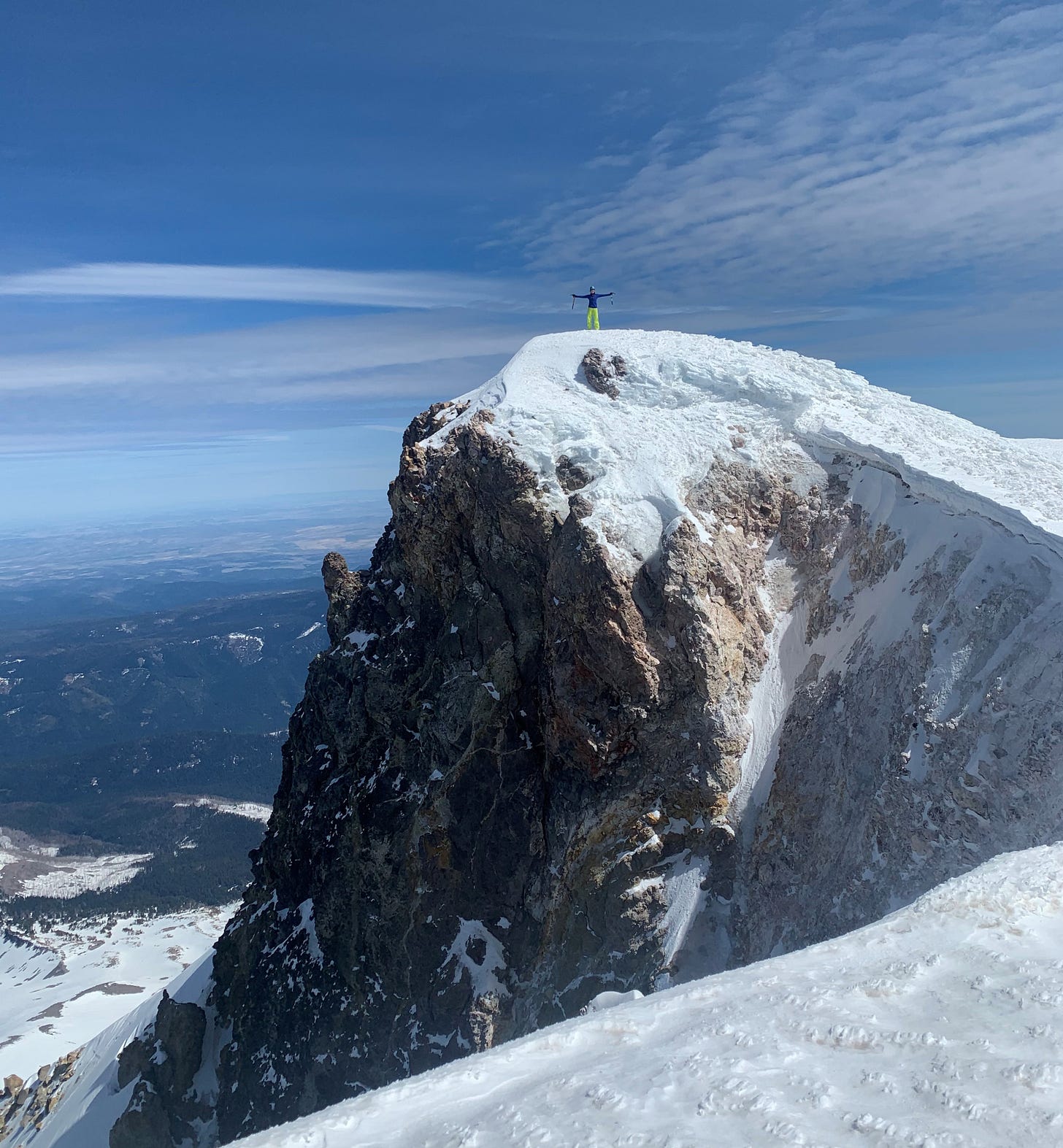
Huge thanks to COROS for sponsoring Trail Mix this month! I became a COROS fangirl when I had to get a watch for my PCT run and needed something with a battery that could hang for such long, long, long days on trail. And holy moly, COROS batteries can hang. I recently climbed a big mountain, went on a 38 mile long run, went for a few weekday runs, and then climbed another mountain, all without popping that thing on a charger and it still had juice for days. I have the APEX and can’t recommend it, or its battery life, enough.
“Look! Ian! I can look down!”
I was yelling up to my boyfriend, who was a few steps ahead of me in the Mazama Chute on Mount Hood. My hands were clinging the two ice tools that I’d speared into the frozen slope to keep my body attached to the mountain – which was a relationship I was quite interested in maintaining for the duration of our time together.
We were climbing Oregon’s tallest volcano and we were on the final push up to the summit – and also on one of the steepest, iciest, and most exposed parts of the climb. It’s the type of terrain that usually gets me sweating through my goretex with an overwhelming fear of plummeting to my physical demise.
The first time I attempted to summit Mount Hood, I got so spooked by the exposure that I had to bail. And the most prominent peak in Oregon has taunted me from the skyline ever since that failed attempt. An 11,250 foot billboard advertising my fears to every corner of the state.
“Seriously?” Ian yelled back. His voice riddled with disbelief. He’s watched me whimper with fear on plenty of steep slopes, including perches with way less exposure than what we were dangling over in this chute.
I waited until he glanced down at me and then got more dramatic than a daytime soap opera to reveal my newfound courage. I made a big show of swiveling my head to look down the mountain. The snow beneath us plummeted into a piping fumarole – giving the mountain below us an ominous Mordor-like feel. Like volcanic jaws waiting to snatch up climbers falling to doom.
I let my gaze linger on the terrain below us to prove that I could do it – as much for me as for Ian.
As I looked down, I scanned the state of my body. My heartrate was shockingly steady. My armpits were reasonably dry. My hands were holding my ice tools with less force than their usual death grip. And my feet were not quaking in my ski boots.
This was some of the more consequential terrain I’d ever been on and I was infinitely more composed than the last time I was on this mountain – and I was pretty sure I knew exactly why that was.
I remembered when I used to have an all-consuming fear of snakes. Those creepy danger noodles could reduce me to blood-curdling screams, long-lasting panic attacks, and body-heaving sobs.
I had to quit babysitting forever after some small hellions released a snake in the house so they could run rampant while I was trapped on an ottoman, frantically scanning the floor for any signs of slithering.
And, I once informed my high school biology teacher that I’d much rather accept an F in his class than have to look at the snake in the aquarium.
And during a particularly low moment, I had a panic attack at a congressional reception for zookeepers when I saw that an anaconda-sized reptile was coiled up in the corner with no cage or leash to restrain him. I started hyperventilating and hysterically crying into my glass of chardonnay as my coworkers escorted me out of the banquet room.
My fear of all reptiles from harmless garden snakes to life-threatening cobras was so crippling that I’d steer clear of the woods and fields of tall grass and anywhere a snake might be lurking. I couldn’t imagine a world where I’d ever want to run somewhere like the rattlesnake-pit of the Grand Canyon or walk through a rainforest where I might bump into the type of snake that could actually hurt me.
But I ended up running on a few trails with friends. And I loved everything about them except for the fact that they overlapped with reptile lairs. And then I started to think about moving out west – where there are plenty of snakes in the wilderness. And I realized I had to confront this fear if I wanted to keep getting out in wild spaces. Which, I really, really did.
So, I googled “how to get over an all-consuming, totally irrational, but very real fear of snakes.” And the internet told me to try exposure therapy, which would involve exposing myself to snakes in increasingly greater doses, while trying to avoid overwhelming myself with too much exposure. So, like, start with pictures of a cartoon garden snake before throwing a real, live boa constrictor over your shoulder.
So, I started looking at photos of single snakes online. Then photos of multiple snakes. Then videos of them slithering around like little demons.
My mom walked in on me watching what could only be described as “snake porn” in her kitchen, and realized just how serious I was about moving out west.
“You’re really going to do this!” she exclaimed. My willingness to YouTube reptiles was more convincing than the dozens of conversations we’d had about my desire to move across the country.
Next, I started walking through short grass. Then tall grass. Then wooded trails.
And the more I did it, the more comfortable I got in that terrain. Even when I spotted a snake by the path. I might still jump and scream, but I could face the fear and keep going. And the more I did it, the easier it got.
This past weekend, I ran the Grand Canyon with my friend Eli and I thought back on how I once swore off getting within 100 miles of that snake pit. When we saw a big fat rat snake slithering off into the bushes, I didn’t want to fondle it, but I could handle my fear of it without melting into a full-blown-full-body panic attack.
My anaconda-sized fear of snakes is an extreme example, but I’ve realized the concept holds true for all kinds of fears. The more we confront them, the more comfortable we can get with our fears. Running at night. Sleeping alone in the woods. Sharing writing on the internet. Public speaking. Climbing mountains with a buttload of exposure.
Every time I’ve seen Mount Hood taunting me from the skyline, I’ve known that one of the keys to summiting was simple: I needed to do more of the thing that scared me away from the tip-top of Oregon.
So this spring, I’ve been climbing mountains with steeper pitches – hoping to log enough steps on scarier slopes that they would eventually start to feel a little less scary. These climbs have been my YouTube snakestream.
By the time I was axe-deep in the Mazama Chute on Mount Hood, I’d spent many hours traversing slices of scarier terrain and I could feel that my relationship with it was changing.
As I looked down the mountain from my perch about 100 feet from the top of the peak, I realized I wasn’t nearly as scared as I used to be. My dry armpits and I were doing okay. It was like seeing that rat snake in the Grand Canyon. I didn’t want to change my mailing address to the Mazama Chute, but I could handle hanging out on this icy little chute for a few minutes.
I thought back to the last time I was on Mount Hood, much lower down the mountain, and remembered how each step rattled me into a tailspin of terror. How I had to bail because my fears got too hot to handle.
The mountain I was climbing was the exact same volcano as it was when I was too scared to keep going. But the way I saw the mountain was shifting. And this time, I could keep going, all the way to the top.
If you dig Trail Mix or a story resonates with you or makes you laugh or cry or laugh cry and you want to say “hey thanks for typing these words and sharing them on the internet,” you can buy me a coffee (or beer!). I can’t thank you enough for supporting this little storyletter. It means the world to me and you all help make Trail Mix keep happening.
It’s so great and appreciated when you share Trail Mix with friends (real life or internet ones). (Link to webpage here!) You can also send me notes about Trail Mix-y things through email, comments, instagram or twitter. I am so grateful for any and all of your Trail Mix-ing!
Trail Mix is a weekly newsletter full of stories about running and life, dispatches from the wilderness, and essays about how it all collides. You can subscribe to Trail Mix for more stories in your inbox.













